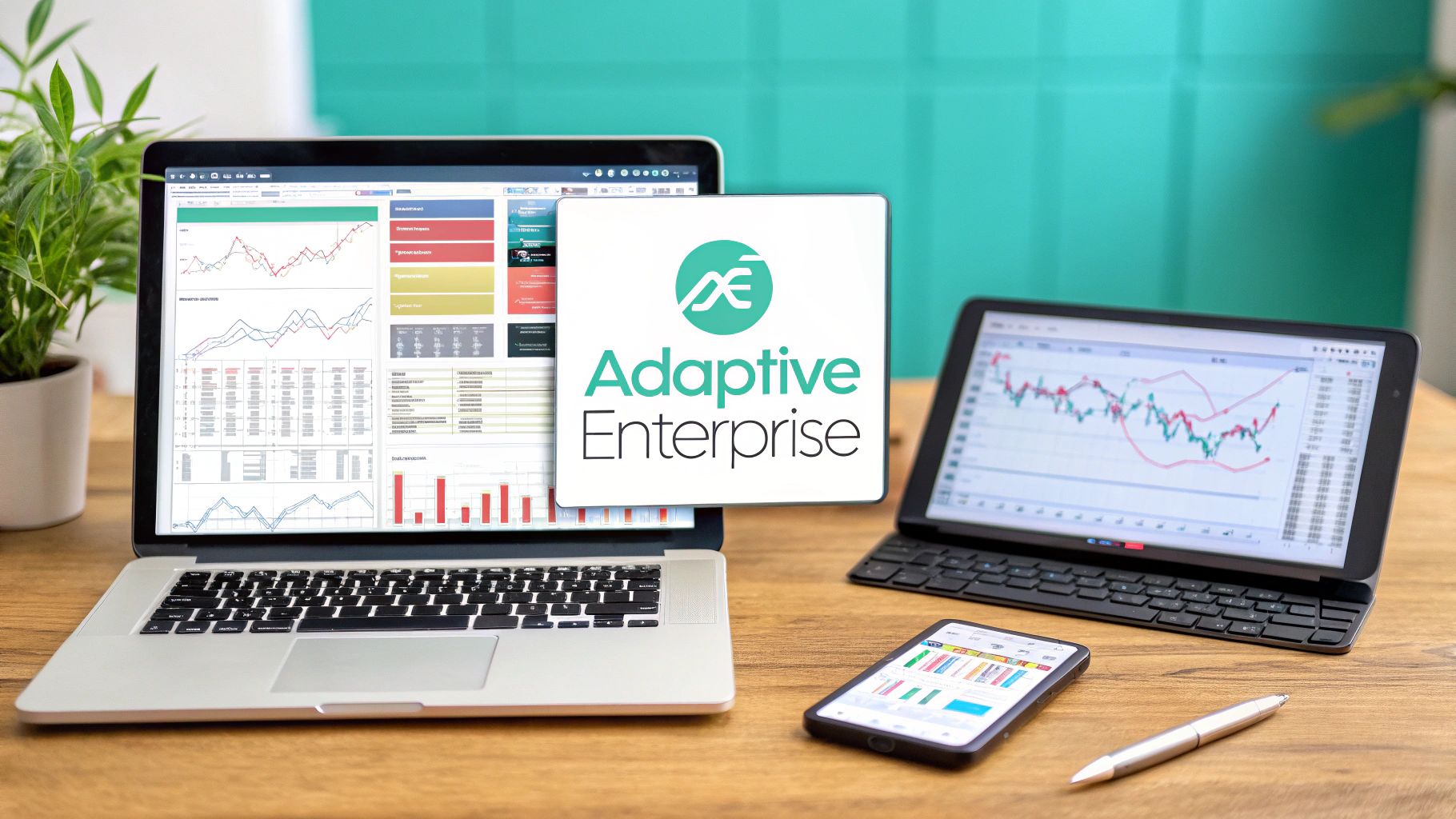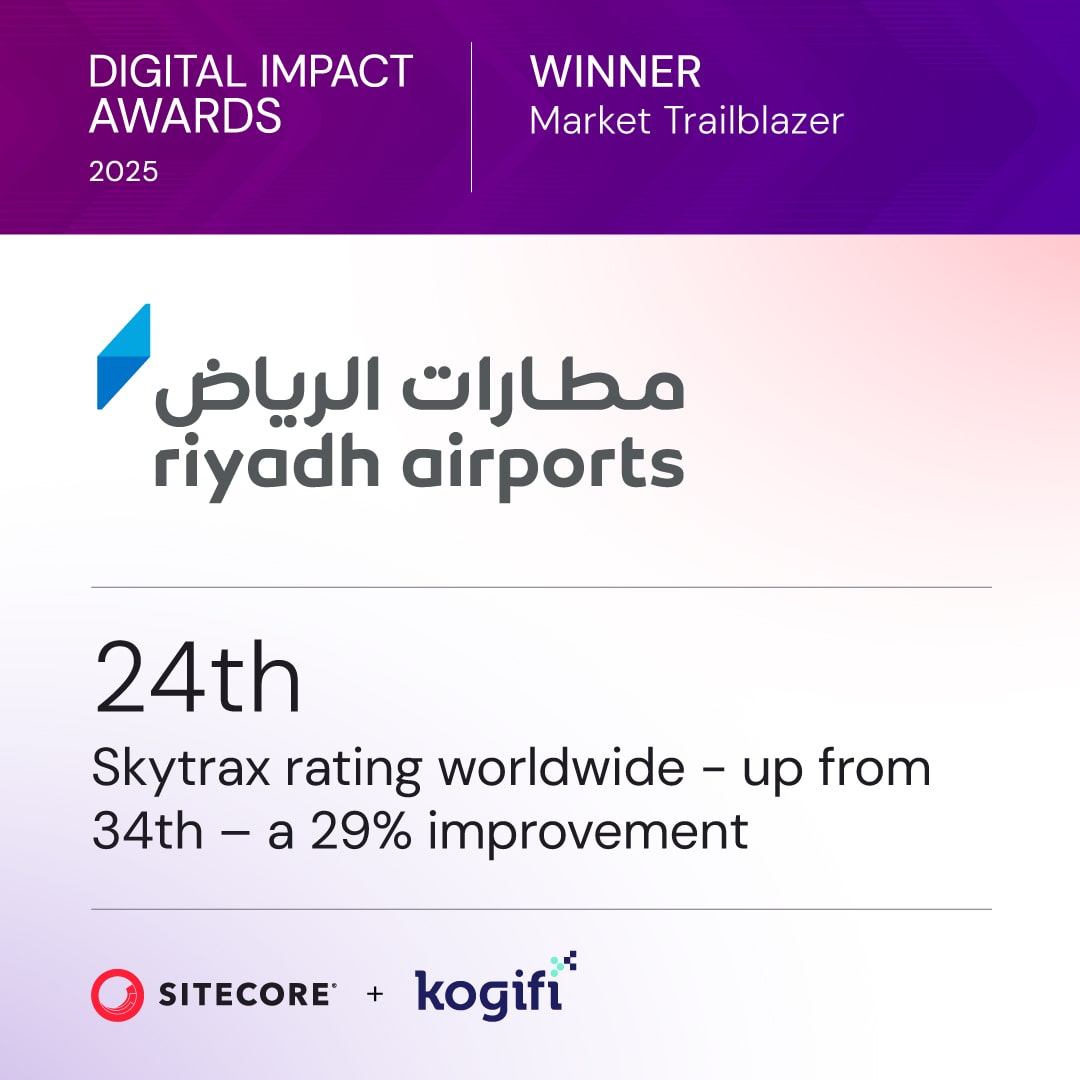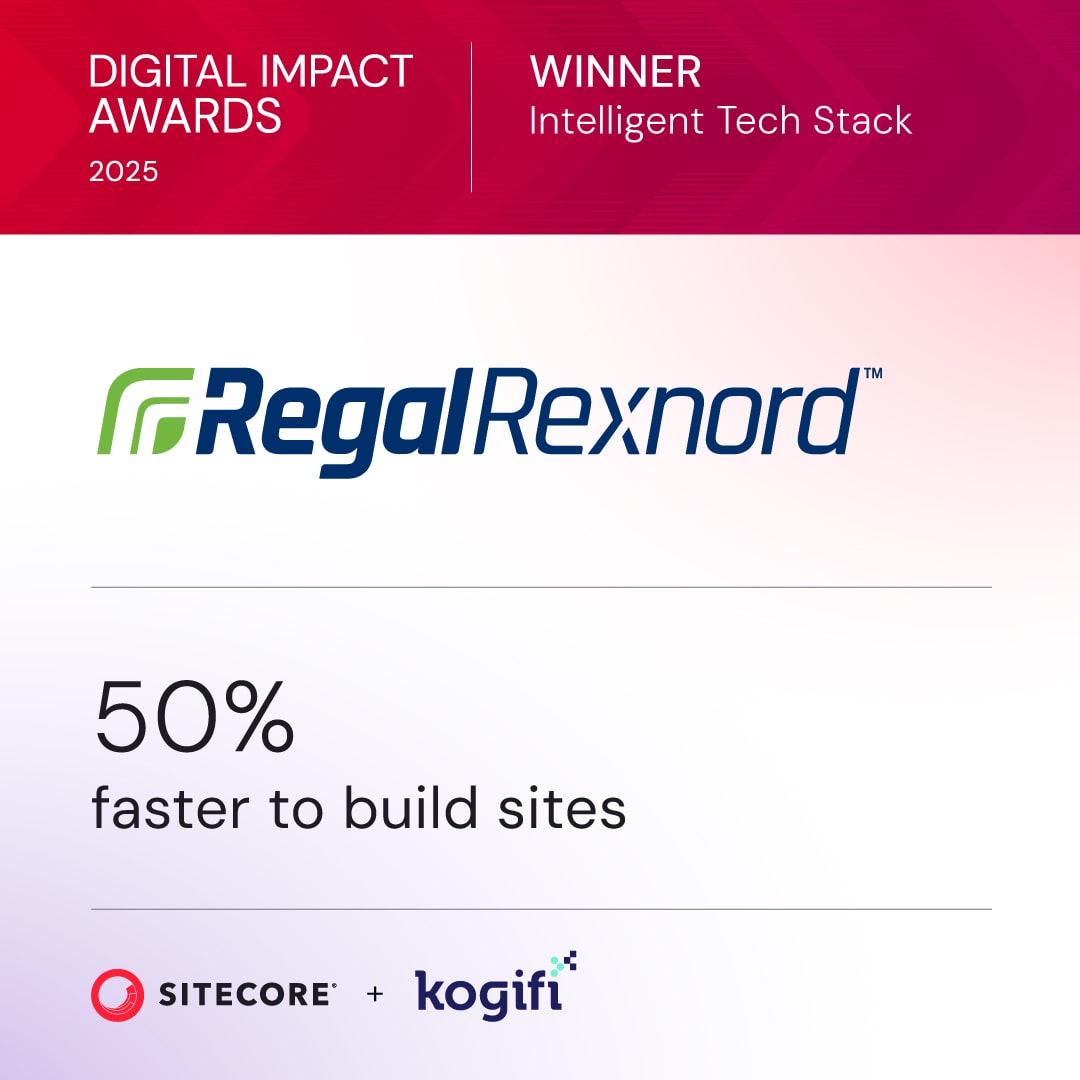Let's be clear: automated content marketing isn't about firing your marketing team and letting robots take over. It’s about building a smart, AI-powered system that handles the grunt work of creating, personalizing, and distributing content at a scale that just isn't humanly possible.
This approach transforms marketing from a long checklist of manual tasks into a powerful, scalable asset for your business, driven by enterprise-grade platforms like Sitecore.
A New Chapter in Content Creation
Welcome to a new era where automation doesn't replace marketers—it gives them superpowers. The demand for a never-ending stream of high-quality, relevant content is relentless, and legacy, fragmented ways of working just can't keep up. This is precisely where automated content marketing, powered by a robust Digital Experience Platform (DXP), steps in to solve the modern headaches of scale, speed, and personalization.

Think of it less as a bunch of separate tools and more like the central nervous system for your entire marketing operation. At the center of it all, a DXP like Sitecore acts as the brain, coordinating every single stage of the content lifecycle. It’s a world away from the chaos of juggling different tools for analytics, asset management, and content delivery, providing a single, unified command center.
Core Principles of Modern Automation
Truly effective automation is guided by a few simple but powerful ideas. It’s about more than just making repetitive tasks go faster; it’s about making every single action smarter and more impactful. The real goal is to create a self-improving system where technology and human strategy work together seamlessly.
The key pillars of this approach include:
- Using AI for Smarter Ideation: Artificial intelligence within the Sitecore ecosystem can sift through market trends, competitor content, and audience data to pinpoint topics and keywords that have the best shot at grabbing attention.
- Automating Workflows for Total Efficiency: From drafting and reviews in SharePoint to enrichment and publishing in Sitecore, automated workflows smash through bottlenecks. This frees up your team to do what they do best: be creative.
- Tapping Into Rich Data for Hyper-Personalization: A DXP brings all your customer data into one place. This allows Sitecore to deliver truly individualized content experiences in real-time, based on what a user is doing on your site right now.
One of the biggest myths about automation is that it kills creativity. The reality is the complete opposite. By taking on the logistical nightmare of content management, automation gives marketers back their time and provides the data-driven insights they need to produce their most creative and strategic work.
From Manual Labor to a Strategic Asset
This shift toward automation completely changes how you think about content creation. What used to be a slow, manual assembly line becomes a fluid, dynamic, and scalable business asset. Platforms like Sitecore are built to handle this complexity, turning your content into a serious engine for growth.
But this transition isn't just about buying new software; it's about adopting a new mindset. It requires a clear vision for how technology will help you hit your business goals. The first step is building a solid framework, and a well-thought-out plan is non-negotiable. You can learn more about laying the groundwork by reading our guide on how to create a content strategy.
Getting this strategic alignment right ensures your automated efforts are always driving measurable business results, transforming your content operations into a genuine competitive advantage.
Core Technologies for Content Automation
To pull off genuine automated content marketing at an enterprise scale, you can't just throw a bunch of disconnected tools at the problem. What you really need is an integrated technology stack, where every piece has a specific and powerful job. This connected ecosystem is what separates simple post-scheduling from the kind of intelligent, real-time content delivery that actually moves the needle.

At the very heart of this modern marketing machine sits Sitecore Content Hub. Think of it as the central nervous system for your entire content operation. It’s far more than a digital filing cabinet; it’s where you manage the entire content lifecycle—from the initial spark of an idea all the way to publication, analysis, and eventual archiving.
Content Hub pulls several mission-critical functions under one roof. Its built-in Digital Asset Management (DAM) keeps every image, video, and document perfectly organized, while the Content Marketing Platform (CMP) puts guardrails around your workflows, calendars, and campaigns. Getting this single source of truth in place is the first—and most important—step toward effective automation.
The Powerhouse Combination of Sitecore and SharePoint
While Sitecore Content Hub is busy managing the strategic side of things, the actual creative process often needs its own dedicated space for collaboration. This is where Microsoft SharePoint shines. It acts as the collaborative backend—a digital workshop where writers, editors, and subject matter experts can draft, review, and finalize content without stepping on each other's toes.
SharePoint’s real strength is in its robust document management, version control, and streamlined internal review cycles. Once a piece of content gets the final green light in SharePoint, it flows directly into Sitecore. This tight integration forges a powerful and efficient content supply chain, connecting the creative engine with the distribution and personalization powerhouse.
Ultimately, this synergy lets your teams work in the tools they know and love, all without creating frustrating data silos or workflow bottlenecks. SharePoint handles the messy, collaborative parts of creation, and Sitecore takes the polished assets and gets them ready for intelligent delivery.
To better understand how these platforms work together, let's break down their roles in a typical automated workflow.
Key Automation Components in a Sitecore & SharePoint Ecosystem
This table highlights how Sitecore and SharePoint each contribute unique strengths to create a seamless, end-to-end automated content marketing framework.
As you can see, each component has a distinct purpose, but they all work in concert to move content from idea to personalized delivery with minimal manual effort.
Driving Personalization with Sitecore's AI Engine
Once your content is locked and loaded in Sitecore, the real automation magic starts. The platform’s AI-driven tools take the wheel, making sure the right message gets to the right person at the perfect moment.
Two key components make this happen:
- Sitecore Personalize: This tool uses machine learning to analyze user behavior as it happens. It tracks clicks, scroll depth, and navigation paths to build a dynamic profile for every visitor, automatically serving up hyper-relevant content, offers, and calls-to-action.
- Sitecore Discover: With a laser focus on commerce, Discover automates everything from product recommendations to search results. It learns from how users interact with your site to surface the most relevant products, boosting conversions and average order value without anyone lifting a finger.
These aren't just simple rule-based tools. Instead of just showing different content to someone from California, they actually predict user intent. This ensures every single interaction feels uniquely personal and context-aware.
This kind of intelligent automation is quickly becoming the new standard. As AI-powered automation becomes a dominant force, leading platforms are integrating these capabilities deeply into their workflows. Leaner content teams can now leverage these tools to scale their output dramatically.
To get the most out of your automation efforts, it’s worth exploring the landscape of available AI-powered SEO tools. Integrating these specialized tools can seriously amplify the capabilities of a platform like Sitecore, ensuring your automated content is not only personalized but also visible in search. This potent combination of a robust DXP and specialized AI tools is the backbone of any truly effective automated content marketing strategy.
Your Automated Workflow from Ideation to Publication
An automated content marketing strategy isn't just a buzzword; it's a real, repeatable process that takes an idea from a spark of inspiration to a published, personalized asset. In a connected ecosystem like Sitecore and SharePoint, this journey isn't a series of clunky, manual handoffs. Instead, it’s a fluid workflow that turns a high-effort sequence into an efficient content pipeline.
Let's walk through this journey step-by-step to see how the right tech at each stage cuts out the friction and gets content to market faster.
Stage 1: AI-Driven Ideation and SEO Research
The workflow doesn't start with a blank page. It starts with data. Instead of guessing what to write about, Sitecore's integrated analytics tools can pinpoint content gaps by analyzing user behavior, on-site search queries, and performance metrics. This is how you discover what your audience is actively looking for but can't find.
AI models can then chew on this data, along with broader market trends and competitor analysis. The result is a prioritized list of high-value topics and keywords that have the best shot at driving engagement and conversions.
This isn't just a keyword list; it's a strategic roadmap. This automated research phase makes sure every piece of content is tied directly to audience demand and business goals from the get-go.
Stage 2: Collaborative Drafting in SharePoint
With a data-backed topic ready, the creative process kicks off in SharePoint. This is the collaborative hub where writers, designers, and subject matter experts come together. Its real strength lies in its powerful document management and review features.
Here’s how automation cleans up this traditionally messy stage:
- Automated Notifications: When a writer finishes a draft, stakeholders get an automatic ping. No more chasing people down with email chains.
- Version Control: SharePoint keeps a crystal-clear history of all changes, so you can easily track edits or roll back to an earlier version if needed.
- Approval Workflows: You can build out multi-step approval gates where a document can’t move forward until the right people have signed off.
This controlled environment ensures every piece of content is thoroughly vetted for accuracy, brand voice, and quality before it even thinks about going live.
Stage 3: Content Enrichment in Sitecore Content Hub
Once a piece of content gets the final thumbs-up in SharePoint, it isn’t just copied and pasted. An automated workflow pushes the approved asset straight into Sitecore Content Hub. This is where raw text is transformed into an intelligent, market-ready asset.
Think of this as the final assembly line. The core content arrives from SharePoint, and Content Hub adds all the essential components needed for intelligent delivery, such as metadata, personalization tags, and channel-specific formatting.
Inside Content Hub, automation helps enrich the content by suggesting relevant tags, categorizing it based on topic, and linking it to related images or videos from the DAM. This step is what makes true, one-to-one personalization possible later. For a closer look at this central platform, check out our guide on streamlining your workflows with Sitecore Content Hub.
Stage 4: Automated Publishing and Personalization
The final stage is where the Sitecore Experience Platform (XP) takes the reins. With the fully enriched content sitting ready in the Hub, Sitecore XP automates its publication across all your channels—your website, a mobile app, an email campaign, you name it.
But it doesn't just publish a single, static version. Using the personalization tags added in the last stage, Sitecore XP can create and serve up thousands of unique content variations in real-time. It analyzes each visitor's behavior and delivers the version most likely to hit the mark. For instance, a first-time visitor might see a general intro, while a loyal customer sees a version that highlights advanced features.
This entire process, from data-driven idea to hyper-personalized delivery, works as one cohesive, automated system. It’s what allows you to truly scale your content marketing without burning out your team.
Measuring the Impact of Your Content Strategy
Automated content marketing is so much more than a production engine—it's a data goldmine. But without the right analytics, you’re just guessing. To really justify the investment, you have to look past vanity metrics like page views and zero in on what actually moves the needle: revenue, leads, and customer loyalty.
This is where a solid Digital Experience Platform becomes non-negotiable. Inside the Sitecore ecosystem, Sitecore Analytics gives you the kind of granular insight needed to draw a straight line from your content to your business goals. It’s built to track the entire customer journey, not just random touchpoints, giving you a clear view of what’s resonating and what’s falling flat.
Setting Up Meaningful Goals in Sitecore
You can't measure what you don't define. Effective measurement starts by clarifying what success actually looks like for your business. Sitecore lets you create and assign Goals to specific actions people take on your website. Think beyond simple conversions; these can be subtle indicators of engagement that show a visitor is getting closer to making a purchase.
You can set up goals for all sorts of critical actions:
- Downloading a whitepaper to see who’s interested in a particular product.
- Completing a "Contact Us" form to measure direct lead generation.
- Watching a product demo video to track engagement with key marketing assets.
- Registering for a webinar to spot highly qualified prospects.
Every time someone completes one of these actions, Sitecore assigns them engagement value points. This builds a detailed profile of their intent and interests over time. Better yet, this data feeds right back into the automation engine, making the personalization for their next visit even smarter.
A/B Testing and Personalization Analytics
Automation lets you test content variations at a scale that would be impossible to do by hand. With Sitecore’s built-in A/B testing capabilities, you can experiment with different headlines, calls-to-action, or images on your automated content. The platform handles the rest, automatically serving different versions to audience segments and declaring a winner based on which one hits a predefined goal.
You can also measure the direct impact of your personalization rules. Sitecore Analytics has reports that show exactly how your personalized content is performing against the default experience. This gives you the hard data to prove that delivering tailored content drives higher engagement and more conversions.
By linking every content piece and personalization rule to a specific business goal, you build a powerful business case for automation. You can definitively show how your automated content marketing efforts are contributing to lead generation, customer lifetime value, and ultimately, sales.
The proof is in the numbers. ROI for content marketing and its core channel, email, shows the power of personalization, with AI techniques boosting open rates and engagement significantly.
Attributing Revenue and Proving ROI
The ultimate goal here is to connect your content directly to revenue. Sitecore makes it possible to map out conversion paths, showing the sequence of content and interactions that led someone from a curious visitor to a qualified lead or paying customer. This multi-touch attribution model finally moves us beyond simplistic "last-click" thinking, giving credit to all the content pieces that nurtured a prospect along their journey.
This visualization shows the streamlined process from content ideation and drafting to final publication, which is the foundation for generating measurable results.
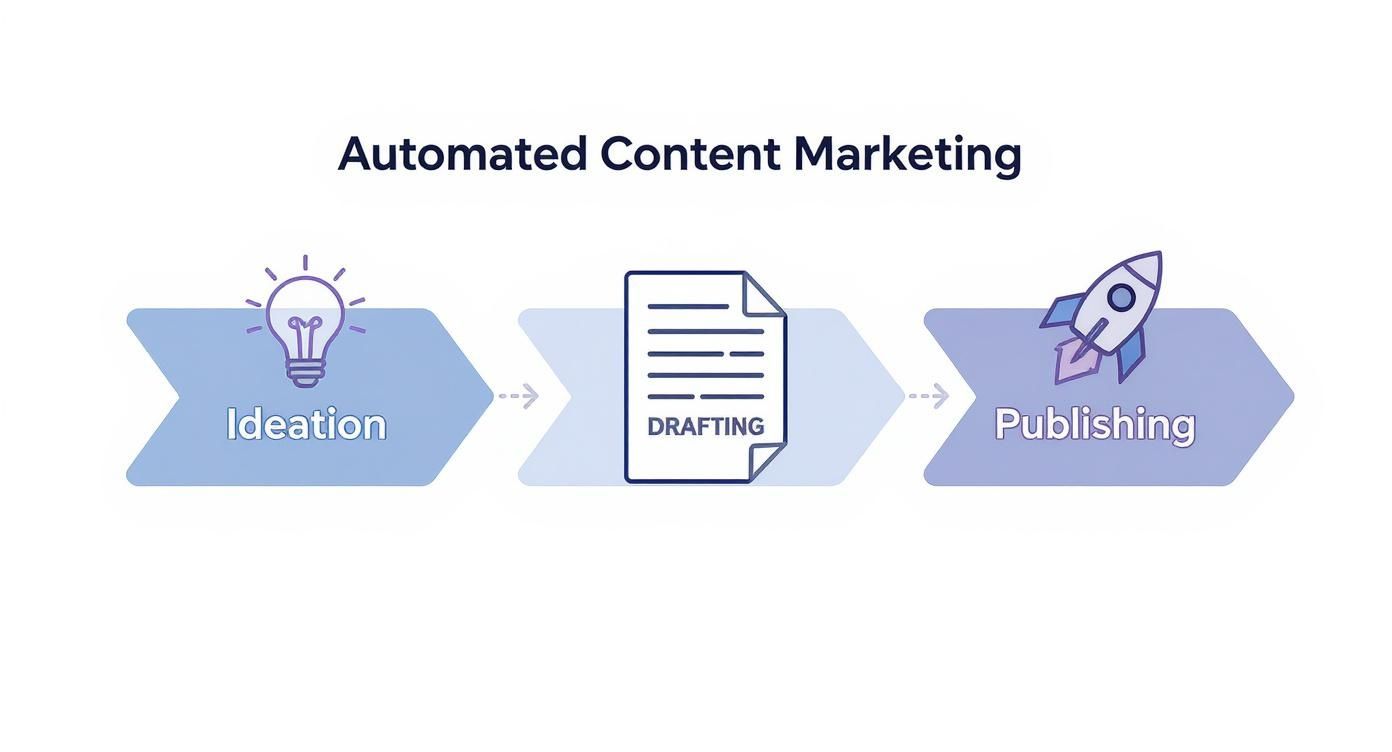
By tracking these automated workflows, you can precisely measure efficiency gains and performance improvements at every stage of the content lifecycle.
This detailed data creates a powerful feedback loop. The insights you gather from your analytics fuel your next wave of automated content, making each campaign smarter and more effective than the last. For a deeper dive into this crucial topic, check out our article on calculating content marketing return on investment. This cycle is how you turn your content strategy into a predictable engine for business growth.
The Business Benefits of Content Automation
It's easy to get lost in the technical weeds of automated content marketing, but the real story is how all that tech translates into tangible business wins. Beyond the clever workflows and AI engines, the value lies in measurable advantages that fuel growth, boost efficiency, and forge a stronger connection with your audience. These aren't just buzzwords; they're real outcomes that directly impact your bottom line.
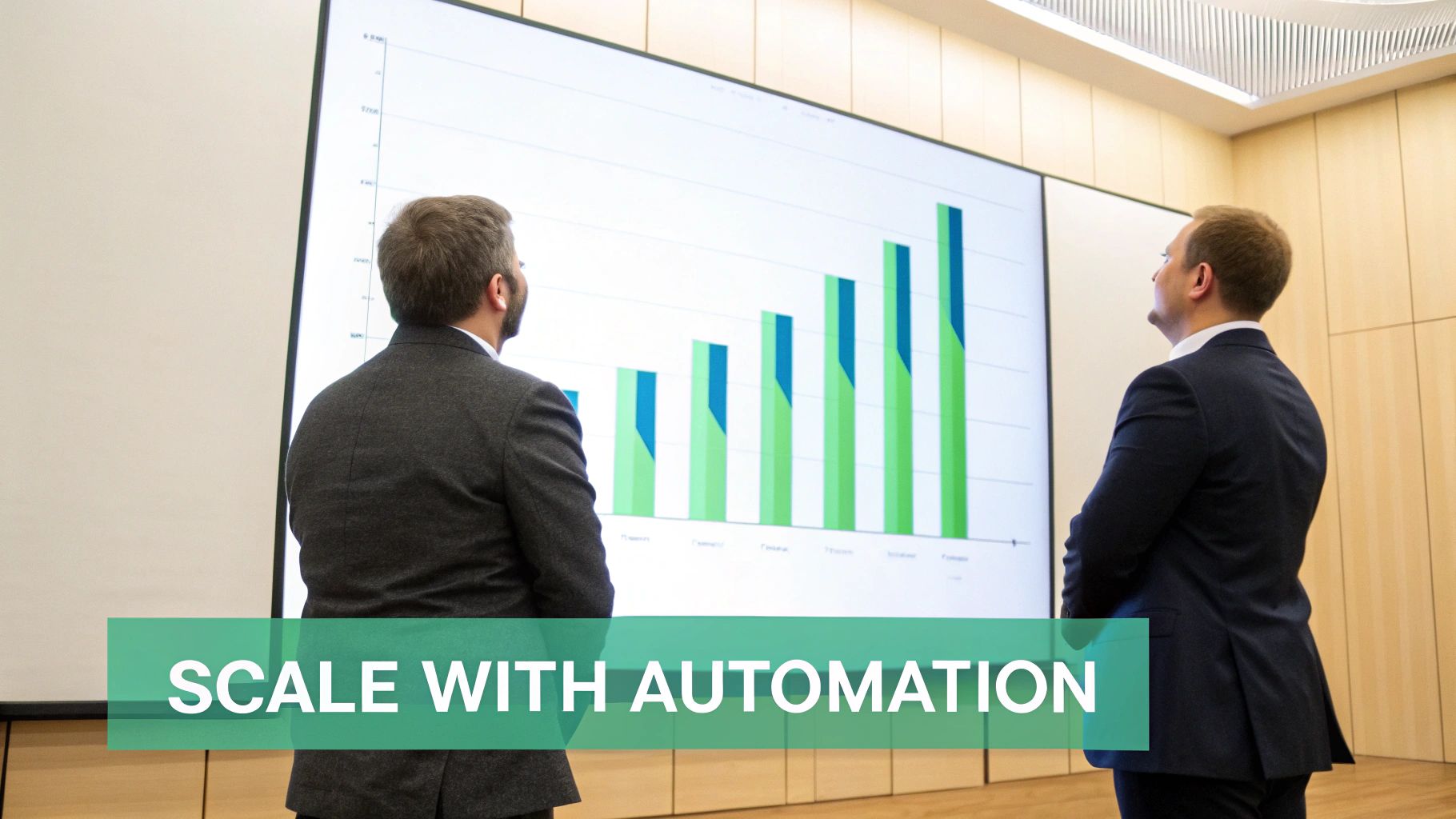
This is the point where platforms like Sitecore and SharePoint stop being just tools and start acting as strategic assets. They solve nagging operational headaches while paving the way for you to lead the market.
Drastically Improved Operational Efficiency
The first and most immediate win from content automation is the sheer reduction in manual grunt work. Tasks that used to eat up weeks of your marketing team’s time—think content research, endless internal reviews, and pushing content to every channel—get folded into smooth, automated workflows. The impact on productivity is huge.
By automating the repetitive, low-value tasks that bog down creative teams, you’re not just saving time; you're reallocating your most valuable resource—human expertise—toward strategy, innovation, and high-level campaign development.
When you have a connected Sitecore and SharePoint ecosystem, content glides from a collaborative draft to a final, published piece. This gets your marketers out of the project management weeds and lets them focus on what they do best: creating content that actually connects with customers.
Hyper-Personalization Delivered at Scale
Giving every single visitor a truly personal experience is the holy grail of digital marketing. Doing it manually is a fantasy. With automation, it becomes a reality. This is exactly what Sitecore Personalize was built for—delivering thousands of unique, context-aware digital experiences at the same time.
It pulls this off by:
- Analyzing real-time behavior to figure out what a user wants in the moment.
- Automating content delivery based on dynamic user segments and profiles.
- Serving up relevant content, offers, and recommendations without a human lifting a finger.
This means you can finally move past broad demographic buckets and start engaging with each customer as an individual. The result? A massive jump in relevance and conversion potential.
Stronger Brand Governance and Consistency
Keeping a consistent brand voice across dozens of channels is a never-ending battle for large companies. Automation, especially through Sitecore Content Hub, builds brand governance right into the process.
It becomes the single source of truth for every piece of content and every digital asset. By setting up predefined workflows and ensuring everyone uses approved, centrally managed assets, you guarantee that every email, blog post, and social update is on-brand, legally compliant, and strategically sound. No more rogue content, just rock-solid brand integrity at scale.
The data backs all of this up. AI-augmented content can generate higher average engagement rates and increased landing page conversions. Better yet, AI-assisted production can slash research and drafting time significantly, allowing teams to finish major content pieces in a fraction of the time.
Frequently Asked Questions
Thinking about bringing content automation into your workflow? You're not alone. It's a big step, and it naturally brings up some important questions, especially when you're working with enterprise platforms like Sitecore and SharePoint. Here are some straightforward answers to the most common ones we hear.
How Does Sitecore Ensure AI-Generated Content Quality?
Sitecore’s philosophy is all about a "human-in-the-loop" approach. While AI is fantastic for speeding up drafting and personalization, the platform is built from the ground up to keep your team in the driver's seat.
You can build mandatory review and approval steps right into your workflows using tools like Sitecore Content Hub and the Experience Platform. This is a critical feature. It means every piece of AI-assisted content gets checked by your experts for accuracy, brand voice, and strategic fit before it ever sees the light of day. This way, you get the incredible speed of AI without sacrificing the essential touch of human expertise.
This built-in governance is what separates true enterprise automation from simple content generation. It maintains quality control while still benefiting from the efficiency of AI, giving you the best of both worlds.
Can We Integrate Existing SharePoint Content with Sitecore?
Yes, you absolutely can. In fact, this is one of the most powerful combinations in an enterprise content setup. Sitecore offers robust connectors and APIs made specifically for a smooth integration with platforms like Microsoft SharePoint.
This setup allows you to use your existing SharePoint library as a "headless" content source. Your teams can stick with the drafting and review processes they already know and love in their familiar SharePoint environment.
At the same time, Sitecore can pull that approved content in to manage, enrich, personalize, and push it out across all your digital channels. It creates a unified content supply chain without forcing your teams to abandon the workflows they rely on.
What Is the First Step to Adopting Content Automation?
The best place to start is with a thorough content audit and workflow analysis. Before you even think about new tools, you need a crystal-clear picture of what content you have, how it's performing, and where the current bottlenecks are in your operations.
Once you have that map, pick a high-impact area for a pilot project. Maybe it's personalizing email campaigns or automating blog topic generation. With a modular platform like Sitecore, you can start small with a specific tool like Sitecore Personalize or the CMP features in Content Hub to prove the ROI on a manageable scale.
This phased approach lets your team learn and adapt as you go, helping you build a rock-solid business case for a full-scale, enterprise-wide implementation.
Ready to transform your content strategy with intelligent automation? Kogifi specializes in implementing powerful Sitecore and SharePoint solutions that drive real business results. Discover how our expertise can empower your digital presence at https://www.kogifi.com.






















